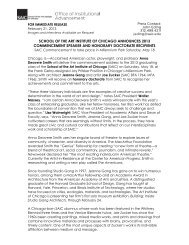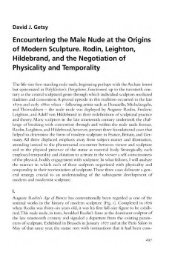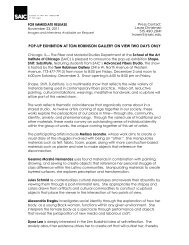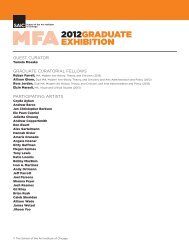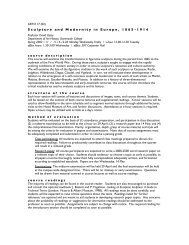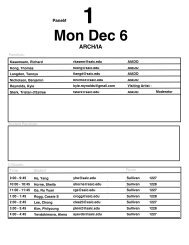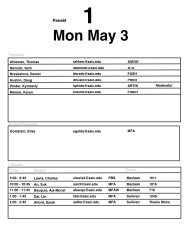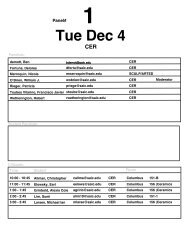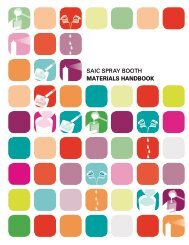i. institutional support and commitment to continuous improvement
i. institutional support and commitment to continuous improvement
i. institutional support and commitment to continuous improvement
Create successful ePaper yourself
Turn your PDF publications into a flip-book with our unique Google optimized e-Paper software.
School of the Art Institute of Chicago<br />
Department of Architecture, Interior Architecture, <strong>and</strong> Designed Objects<br />
Master of Architecture<br />
Master of Architecture with emphasis in Interior Architecture<br />
b) Strategic initiatives<br />
If the Core Values are the principles with which the planning process is <strong>to</strong> be guided, the Stra-<br />
tegic Initiatives are the tactical instructions for how <strong>to</strong> reach the School’s five-year goals. These<br />
marching orders are intended <strong>to</strong> be carried out by one of several Action Groups that will be<br />
formed in Fall 2010 semester. The Action Groups may be newly formed committees of faculty,<br />
staff, <strong>and</strong>, where appropriate, students, or they may focus the efforts of existing committees.<br />
Drafted <strong>and</strong> vetted simultaneously with the values, the initiatives describe a challenge the<br />
Strategic Planning Committee has identified as both pressing <strong>and</strong> actionable. Then they out-<br />
line expected outcomes, which would arise from the ameliorative activity of the Action Groups.<br />
Finally, each initiative charges an action group with an ultimate goal, suggesting benchmarks<br />
<strong>and</strong> assessment <strong>to</strong>ols that may be helpful in adjudicating each goal. By their nature, each of<br />
the strategic initiatives is less succinct than the values; therefore, the Strategic Initiatives, with<br />
summaries of their contents are:<br />
o Develop Funding Beyond Current Tuition Sources<br />
This initiative refers both <strong>to</strong> the situation in which the School gains the majority of its<br />
revenue from tuition <strong>and</strong> that the number of newly college-age students over the next<br />
several years in the United States is expected <strong>to</strong> decline. Finding avenues <strong>to</strong> diversifying<br />
income <strong>and</strong> bolster development efforts is the goal of this initiative.<br />
o Focus on Organizational Effectiveness<br />
This initiative highlights that SAIC, known for its innovativeness in vanguard art<br />
instruction, is more experienced growing the organization through new programs <strong>and</strong><br />
degree tracks than efficiently maintaining its day-<strong>to</strong>-day operations. Establishment of<br />
increasingly transparent, predictable, <strong>and</strong> fair administrative processes is the goal of this<br />
initiative.<br />
o Develop a Campus Master Plan<br />
This initiative focuses on how <strong>to</strong> better, more quickly, <strong>and</strong> more predictably address the<br />
always-advancing technology needs of art <strong>and</strong> design-making equipment, particularly<br />
in an urban, vertical campus, which minimizes the collective, community-building spaces<br />
associated with the university quad. Making a flexible, responsive plan for the physical<br />
plant of the School is the goal of this initiative.<br />
o Build Diversity<br />
This initiative continues the centrality of desire for a diverse SAIC, free from systemic<br />
impediments in faculty, students, <strong>and</strong> staff recruitment. It also charges the Action Group<br />
<strong>to</strong> consider the diversity of opinions <strong>and</strong> practices embodied in the School as well as the<br />
community’s national, racial, class, <strong>and</strong> gender identity profile. Setting new, distinctive<br />
benchmarks for assessing <strong>and</strong> methods for improving our diversity is the goal of this initiative.<br />
o Find the SAIC Student<br />
This initiative recognizes that the open, flexible curriculum of SAIC is not easily navigated<br />
by all students. Nuanced recruitment procedures <strong>to</strong> better identify ideal students as well<br />
as the establishment of a more robust transfer-student orientation processes are the goals<br />
of this initiative.<br />
o Provide Structure <strong>and</strong> Support for Students<br />
Even when recruiting the ideal SAIC student, the open curriculum can be daunting for<br />
new students, particularly young undergraduates. Moni<strong>to</strong>ring <strong>and</strong> evaluating a new series<br />
Architecture Program Report | 32



